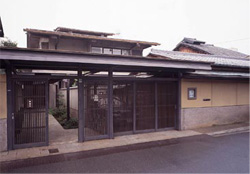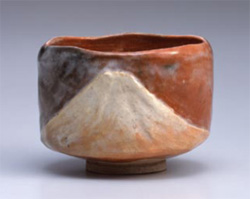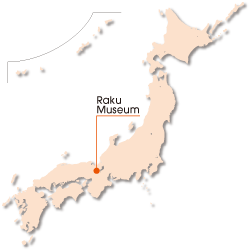Home > Highlighting JAPAN > Highlighting Japan FEBRUARY 2012 > Raku Museum
Highlighting JAPAN
THE NATION’S MUSEUMS
Raku Museum
The Raku Museum in Kyoto has also served as the home and workshop for fifteen generations of the famed Raku ware potters who give it its name. Julian Ryall had a good look around.

The Raku Family built their house and workshop in the present address in Kyoto 450 years ago. The present Raku house, a Registered Cultural Property, was rebuilt in 1855 following the Great Fire of that year.
Credit: COURTESY OF RAKU MUSEUM
Work to create the perfect receptacle for the tea ceremony has been going on for centuries, with Raku Kichizaemon the fifteenth-generation of craftsmen to work in the unique Raku ware style of tea bowls.
Raku Kichizaemon has his workshop and home in central Kyoto, a stone’s throw to the west of the former Imperial Palace, with a museum attached where some of the most important works of Raku ware are on display. The museum also houses tea ceremony utensils, Raku tableware, scrolls and other documents that provide a unique insight into the 400 years of history of the tradition.
“Glazed pottery started in Kyoto in the sixteenth century and Raku ware played a pioneering role. Raku tea bowls produced by Raku Chojiro embodied the aesthetics of Kyoto culture and fashion in their form, glazing and color,” says Yui Inoue, curator of the Raku Museum.
“Raku tea bowls are unique because they were born out of philosophical inspirations and not out of decorative needs,” Inoue adds. “Kyoto, at the center of cultural communication and sophistication, gave the impetus to the birth of this unique form of ceramics.”
Cleverly, the museum has been created to feel as if the visitor is entering the precincts of a teahouse.

Tea bowl by Kakunyu (1918–1980), whose work is characterized by a “modern” look
Credit: COURTESY OF RAKU MUSEUM
The history of Raku ware goes back to the end of the sixteenth century, when Sen Rikyu asked Chojiro, the first generation of the Raku family, to make bowls for chanoyu, the tea ceremony. Rikyu was the leading tea master of the 1500s, when he perfected wabicha, a form of the tea ceremony with a deeply spiritual dimension.
The red and black Raku tea bowls that Chojiro produced from the early 1580s are a distillation of Rikyu’s aesthetic and its idealization of the austere, the understated and the incomplete.
Raku tea bowls have a number of distinctive characteristics, one of which is that they are handmade without the use of a potter’s wheel. The method used to create these bowls is known as tezukune, meaning kneaded by hand, and is peculiar to the Raku family.
Another unique feature of the family’s practice is that the bowls are fired individually in a small unique kiln, instead of in larger quantities. The clay that is used is highly plastic and, when fired, has a particular warmth and softness.
The family has a collection of around 1,100 works taken over by successive heads from Chojiro, and the displays in the museum are changed four times a year. Handling sessions are also held from time to time [the next on March 4], at which visitors are invited to deepen their understanding and appreciation of the bowls.
Displayed simply throughout three galleries, the works really do speak for themselves.
A red Raku bowl with a design of a young pine branch, created by Raku Chonyu VII in the 1700s, is of the thicker style that he favored, while a nearby piece by Tanyu X from the following century has a more elaborate design of people playing drums to mark the arrival of New Year in Kyoto.
Many of the bowls have artistic form which is the opposite to excessive design, instead relying on the simplicity and unique nuances of the receptacle itself for its appeal. A cylindrical tea bowl named Frost Columns is remarkable because of its tall and thin shape, but is eye-catching due to its glistening veil glaze. Another, by Sanyu VI, who practiced in the early decades of the 1700s, is pale red and squeezed in the middle to remind us of the puffy face of Tafuku, the goddess of mirth.
The designs are inventive and unique, ranging from depictions of fresh grass through fish scales, plum trees and willow branches, but a personal favorite is the series of three bowls by Kakunyu XIV from the middle of the 1900s that depicts the three stages of the sun rising over the unmistakable outline of Mount Fuji.
| Access and Admission |  |
|
| Address: | 84 Aburanokoji, Nakadachuri-agaru, Kamigyo Ward, Kyoto 602-0923. | |
| Tel/Fax: | +81 75 414 0304/+81 75 414 0307. | |
| Website: | www.raku-yaki.or.jp/e/museum/index.html | |
| Opening Hours: | 10 a.m. to 4:30 p.m. (last admission at 4 p.m.). Closed on Mondays, except national holidays, and when new exhibitions are being prepared. | |
| Tickets: | 800 yen for adults, 600 yen for university students and 300 yen for children. | |
© 2009 Cabinet Office, Government of Japan






